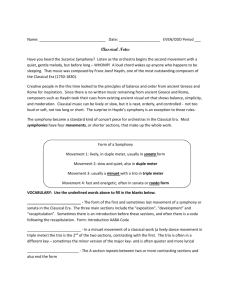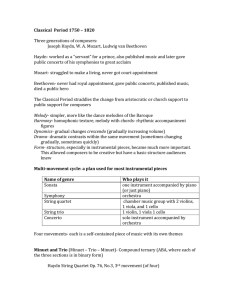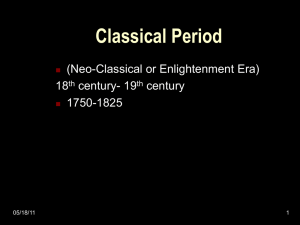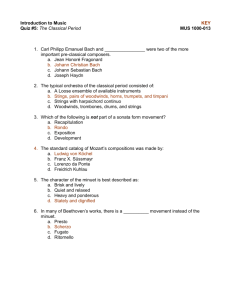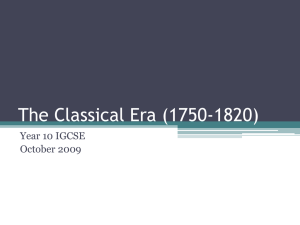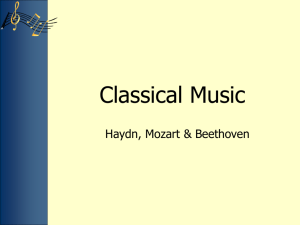YOUR NAME ____________________________________________________ INTRODUCTION TO MUSIC:
advertisement
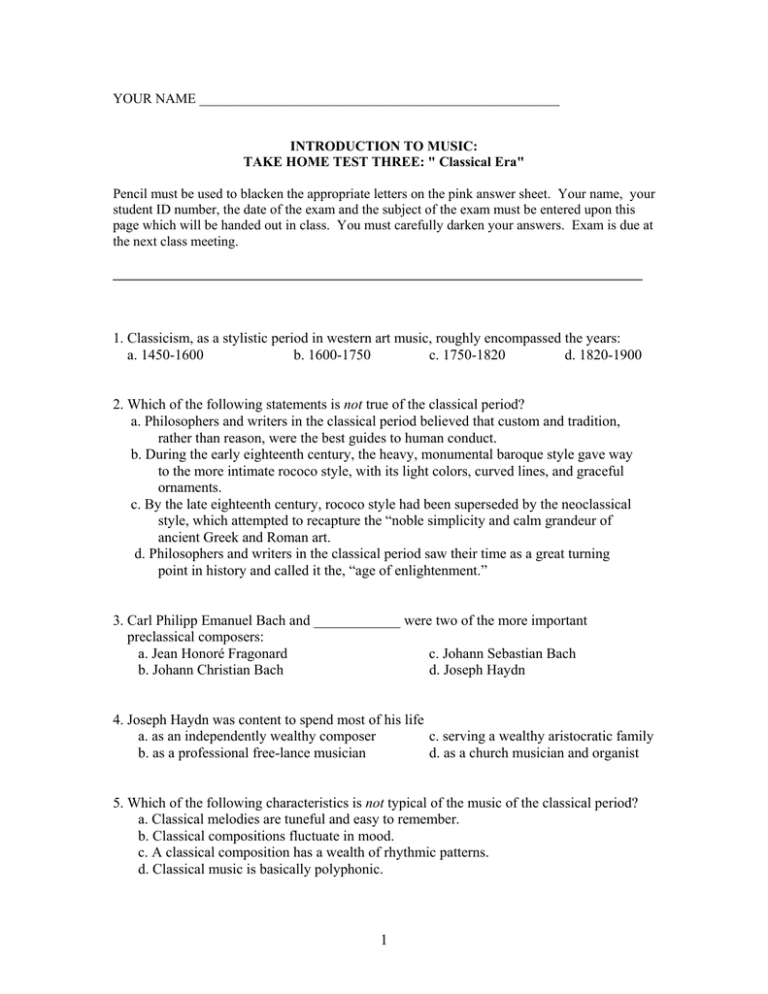
YOUR NAME ____________________________________________________ INTRODUCTION TO MUSIC: TAKE HOME TEST THREE: " Classical Era" Pencil must be used to blacken the appropriate letters on the pink answer sheet. Your name, your student ID number, the date of the exam and the subject of the exam must be entered upon this page which will be handed out in class. You must carefully darken your answers. Exam is due at the next class meeting. _____________________________________________________________________ 1. Classicism, as a stylistic period in western art music, roughly encompassed the years: a. 1450-1600 b. 1600-1750 c. 1750-1820 d. 1820-1900 2. Which of the following statements is not true of the classical period? a. Philosophers and writers in the classical period believed that custom and tradition, rather than reason, were the best guides to human conduct. b. During the early eighteenth century, the heavy, monumental baroque style gave way to the more intimate rococo style, with its light colors, curved lines, and graceful ornaments. c. By the late eighteenth century, rococo style had been superseded by the neoclassical style, which attempted to recapture the “noble simplicity and calm grandeur of ancient Greek and Roman art. d. Philosophers and writers in the classical period saw their time as a great turning point in history and called it the, “age of enlightenment.” 3. Carl Philipp Emanuel Bach and ____________ were two of the more important preclassical composers: a. Jean Honoré Fragonard c. Johann Sebastian Bach b. Johann Christian Bach d. Joseph Haydn 4. Joseph Haydn was content to spend most of his life a. as an independently wealthy composer c. serving a wealthy aristocratic family b. as a professional free-lance musician d. as a church musician and organist 5. Which of the following characteristics is not typical of the music of the classical period? a. Classical melodies are tuneful and easy to remember. b. Classical compositions fluctuate in mood. c. A classical composition has a wealth of rhythmic patterns. d. Classical music is basically polyphonic. 1 6. Which of the following statements is not true? a. In the classical period, composers were influenced by folk and popular music. b. While a late baroque musical composition may convey a single emotion, a classical composition will fluctuate in mood. c. Composers in the classical period tended to use terraced dynamics in their compositions. d. The basso continuo was gradually abandoned during the classical period. 7. Composers in the classical period took middle class tastes into account by a. flavoring their serious compositions with folk and popular music. b. writing comic operas that sometimes ridiculed the aristocracy. c. writing dance music for public halls. d. all of the above. 8. Which of the following statements is not true of the music of the classical period? a. Classical composers stressed balance and clarity of structure. b. The standard orchestra comprised of four sections evolved during the classical period. c. The basso continuo was the nucleus of the instrumental ensemble. d. Classical melodies are among the most tuneful and easy to remember. 9. The prospering middle class in the classical period sought aristocratic luxuries such as a. theater b. literature c. music d. all of the above 10. Which of the following statements is not true? a. Because of the political and social upheaval of the time, there was little demand for printed music, instruments, or music lessons. b. Joseph Haydn’s contract of employment shows that he was considered a skilled servant, like a gardener or gamekeeper. c. Serious composition was flavored by folk and popular music. d. Comic operas in the classical period treated middle-class subjects, had folklike tunes, and sometimes even ridiculed the aristocracy. 11. The Third Symphony of Beethoven was originally composed to commemorate the deeds of _______ a. Napoleon Bonaparte b. George Washington c. the Marquis de Lafayette d. The Duke of Wellington 12. Vienna in 1800 a. was the fourth-largest city in Europe b. was the seat of the Holy Roman Empire c. had a population of almost 250,000 d. all of the above 13. In the classical period, comic operas sometimes a. were based on the Old Testament b. ridiculed the aristocracy c. were in Latin d. all of the above 2 14. In Vienna, Haydn and Mozart a. avoided each other b. became close friends c. were jealous of each other d. never met 15. Haydn and Mozart wrote many outdoor entertainment pieces, which they called a. sonatas b. divertimentos c.concertos d. symphonies 16. The typical orchestra of the classical period consisted of a. a loose ensemble of available instruments b. strings, pairs of woodwinds, horns, trumpets, and timpani c. strings with harpsichord continuo d. woodwinds, trombones, drums, and strings 17. Which of the following instruments were not normally included in the classical orchestra? a. French horns b. trombones c. timpani d. trumpets 18. A symphony is a a. sonata for orchestra b. work for solo instrument c. work for chorus and orchestra d. work for piano solo 19. Sonata form is used frequently as the form for the _________ movement of a multimovement work. a. first b. slow c. final fast d. all of the above 20. Sonata form consists of three main sections, exposition, development, and a. introduction b. recapitulation c. motives d. transition 21. The three main sections of a sonata-form movement are often followed by a concluding section known as the a. coda b. theme c. bridge d. motive 22. A transitional passage that leads to a contrasting section is called a a. coda b. theme c. bridge d. motive 23. Which of the following statements is not true? a. The term sonata refers to the form of a single movement, and it should not be confused with the term sonata, which is used for a whole composition made up of several movements. b. The second theme returns in the recapitulation of a sonata form movement in an exact repetition of its statement in the exposition. c. The coda of a sonata form movement rounds off the movement by repeating themes or developing them further. d. A fast movement in sonata form is sometimes preceded by a slow introduction that creates a strong feeling of expectancy. 3 24. A feeling of harmonic tension and forward motion is created in the exposition of a sonata form movement by a. the conflict of tonalities between the first and second themes b. the introduction of a new theme in the bridge c. retaining the same tonality for both themes d. changing the meter of the second theme 25. A modulation from the home key to a new key in the exposition of a sonata form movement takes place in the a. coda b. theme c. bridge d. motive 26. In the exposition of a sonata-form movement a. the closing theme is in the tonic key b. a new theme is always presented in the bridge c. the second theme is in a new key. d. a new meter enters with the second theme. 27. At the end of a classical exposition there usually is a a. new tempo indication b. new time signature c. repeat sign d. coda sign 28. Short musical ideas or fragments of themes that are developed within a composition are called a. codas b. rides c. melodies d. motives 29. In the recapitulation of a sonata-form movement a. all the principal material is in the tonic key b. a new theme is presented in the bridge c. the second theme is in a new key d. there is no second theme 30. Which of the following is not part of a sonata form movement? a. recapitulation b. rondo c. exposition d. development 31. Sonata form should be viewed as a. a rigid mold into which musical ideas are poured b. another term for the symphony c. a set of principles that serve to shape and unify contrasts of theme and key d. a set of variations on a theme 32. The standard catalog of Mozart’s compositions was made by a. Ludwig von Kochel b. Franz X. Sussmayr c. Lorenzo da Ponte d. Friedrich Kuhlau 33. Which statement about "theme with variations" is not true a. each variation differs greatly in length from the original theme b. Haydn's Surprise Symphony's Second Movement is in 'theme and variations' form. c. the form is frequently used in the Classical Era d. The form may be schematically outlined as A A' A" A''' A"" 4 34. Theme-and-variations form may be schematically outlined as a. AABB b. AA’A’’A’’’A’’’’ c. ABA d. ABACADA 35. Which of the following statements is not true? a. Each variation in a theme and variations form movement is unique and may differ in mood from the theme b. The form called theme and variations is widely used in the classical period, either as an independent piece or as one movements of a symphony, sonata, or string quartet. c. The first movement of Haydn’s Surprise symphony is in theme and variations form d. In a theme and variations movement, a basic musical idea is repeated over and over and is changed each time. 36. Which of the following elements Is usually not changed in varying the theme in theme and variations form? a. melody b. harmony c. length d. rhythm 37. The _________ movement of Haydn's Surprise Symphony is in theme and variations form. a. first b. second c. third d. fourth 38. The minuet and trio movement of a classical symphony, string quartet, or other work, is in ____________ form. a. ABA b. AABB c. AA’A’’A’’’A’’’’ d. ABACABA 39. The movement of a sonata-type composition often patterned after a dance is the a. first b. second c. third d. fourth 40. The minuet is generally the __________ movement of a classical piece a. first b. second c. third d. fourth 41. The form known as minuet and trio is employed as the __________ movement of classical symphonies, string quartets, and other works. a. first b. second c. third d. fourth 42. The minuet first appeared around 1650 as a(n) a. instrumental composition for the concert performance b. prayer in Germany at the end of the Thirty Year’s War c. dance at the court of Louis XIV of France d. country dance in England 43. The character of the minuet is best described as a. brisk and lively b. quiet and relaxed c. heavy and ponderous d. stately and dignified 44. Which of the following statements is not true? a. The minuet movement of a symphony or string quartet is written for listening, not dancing b. The character of the minuet is best described as brisk and lively 5 c. In many of Beethoven’s compositions, the third movement is not a minuet but a related form in the triple meter called scherzo d. The scherzo differs from the minuet in that it moves more quickly, generating energy, rhythmic drive, and rough humor 45. The minuet as a whole may be outlined as a. ABA b. AABB c. ABC d. AABBCC 46. Which of the following is not true of the minuet? a. triple meter b. moderate tempo c. quick, lively tempo d. ABA form 47. In many of Beethoven’s works, there is a ___________ movement instead of the minuet. a. presto b. scherzo c. fugato d. ritornello 48. The scherzo differs from the minuet in that it a. moves more quickly b. has a different form c. has a different meter d. all of the above 49. The double bass in the classical orchestra, as in Mozart’s Eine Kleine Nachtmusik usually a. has a separate and distinct bass part c. doubles the cello part an octave lower b. doubles the cello part in the same register d. sounds an octave lower than the cello part 50. The rondo may be schematically outlined as a. ABACABA b. AABB 51. A common rondo pattern is a. ABACA b. ABACBA C ABBABC c. ABBABC d. ABA d. ABCBA 52. The return of the main theme in rondo form is all the more welcome because it is usually a. in a contrasting key b. in the tonic key c. slow and dignified d. in varied form 53. Because of its liveliness, regularity, and buoyancy, the rondo most often serves as a a. slow movement b. first movement c. set of variations d. finale 54. Beethoven's late works, composed after he was totally deaf, include: a. Piano sontatas b. string quartets c. the Ninth symphony d. all of the above 55. The sonata-rondo a. may be outlined as ABA-development section-ABA b. combines rondo form with elements of sonata form c. usually has a lively, pleasing, and simple to remember theme d. all of the above 56. The main theme of the rondo a. returns only once in the movement c. seldom ends the movement 6 b. is usually slow and dignified d. is usually in the tonic key 57. The rondo was used a. only in the classical symphony and quartet b. only as an independent composition c. as late as the twentieth century d. exclusively in the classical period 58. Symphony may be defined as a(n) a. musical composition for orchestra, usually in four movements b. sonata for orchestra c. extended, ambitious composition exploiting the expanded range of tone color and dynamics of the classical orchestra d. all of the above 59. The usual order of movements in a classical symphony is a. fast, dance-related, slow, fast c. fast, slow, fast, slow b. fast, slow, dance-related, fast d. slow, fast, slow,fast 60. The first movement of a classical symphony is almost always fast and in ___ form a. sonata b. rondo c. minuet d. ABA 61. Which of the following is not true of the symphony? a. A musical composition for orchestra, usually in four movements b. A sonata for orchestra c. An extended, ambitious composition exploiting the expanded range of the color and dynamics of the classical orchestra d. A musical composition for solo instrument and orchestra 62. ABA form is typical of the minuet or scherzo movement and is also common in the a. finale b. first movement c. slow movement d. all of the above 63. The slow movement of a classical symphony a. is sometimes in theme and variations form b. is generally not in the tonic key c. contains broad songlike melodies d. all of the above 64. The last movement of a classical symphony a. is most often in sonata or sonata-rondo form b. is usually fast, lively, and brilliant, but somewhat lighter in mood than the opening movement c. is always in the tonic key of the symphony d. all of the above 65. A symphony is unified partly by the use of the same a. key in three of its movements c. tempo throughout b. theme for each of its movements d. all of the above 7 66. A concerto is a large-scale work in several movements for a. an instrument soloist c. any combination of instruments b. an instrumental soloist and orchestra d. symphonic orchestra 67. Mozart and Beethoven wrote a number of concertos for their favorite solo instrument, the a. cello b. violin c. flute d. piano 68. The classical concerto differs from the symphony in that it does not have a __ movement a. sonata form b. slow c. minuet or scherzo d. rondo finale 69. The symphonic movement usually lacking in the concerto is the a. sonata-form movement c. minuet or scherzo b. slow movement d. rondo finale 70. A brilliant solo section in a concerto designed to display the performer’s virtuosity is called a. a cadenza b. a fermata c. a pause d. da capo 71. A pause in the score of a concerto is indicated by a a. signal from the soloist c. signal from the conductor b. signal from the concertmaster d. fermata 72. Classical chamber music is designed a. to display the virtuosity of the players b. for the intimate setting of a small room c. exclusively for performance by paid professional musicians d. to be conducted by experienced orchestral directors 73. A major factor that distinguishes chamber music from the symphony or concerto is that chamber music a. does not use sonata form c. does not have difficult parts b. is performed in concert in concert halls d. is performed by one player per part 74. The most important form of classical chamber music is the a. violin and piano sonata c. piano trio b. string quintet d. string quartet 75. The string quartet a. usually consists of four movements b. is the most important form in classical chamber music c. is written for two violins, viola, and cello d. all of the above 76. The classical string quartet is a musical composition for a. violin, viola, cello, and bass c. violin, guitar, viola, and cello 8 b. two violins, viola, and cello d. all of the above 77. Which of the following statements is not true? a. Classical chamber music does not need a conductor b. The piano trio is a musical composition for three pianos c. Chamber music is subtle and intimate, intended to please the performer as much as the listener. d. The most important form in classical chamber music is the string quartet 78. The usual order of movements in a classical string quartet is a. fast, slow, minuet or scherzo, fast b. fast slow, fast, slow c. slow, fast, slow, fast d. fast, slow, fast 79. Haydn was fortunate in having a long and fruitful, as well as financially stable relationship with the noble Hungarian family of a. Esterhazy b. Stefanhazy c. Liszt d. Kadar 80. Which of the following was not one of Haydn’s duties while in the service of the Esterhazys? a. composing all the music requested by his patron b. conducting the orchestra of about 25 players c. coaching the singers for operatic performances d. teaching music to the choir boys 81. Haydn’s duties while in the service of the Esterhays included a. composing all the music requested by his patron b. conducting the orchestra of about 25 players c. coaching the singers for operatic performances d. all of the above 82. Along with his symphonies, Haydn’s __ are considered his most important works a. operas b. string quartets c. baryton trios d. serenades 83. Which of the following is not a characteristic of Haydn’s music a. The music is robust and direct, radiating a healthy optimism b. The minuets often romp and stomp rather than bow and curtsy c. There are few changes in texture and orchestration d. Many works have a folk flavor, due to the use of actual peasant tunes and original melodies in folklike style. 84. Which of the following statements is not true? a. Haydn’s position at Esterhaza was that of a highly skilled servant b. Haydn was good-humored and unselfish, and cared about the personal interests of his musicians 9 c. Haydn composed two oratorios, The Creation and Judas Maccabaeus d. Haydn was a master at developing themes, able to build whole movements out of single main themes 85. Haydn was a prolific composer, as demonstrated in part by his 68 string quartets and 104 a. operas b. serenades c. songs d. symphonies 86. Haydn’s two popular oratorios are entitled The Seasons and a. The Creation b. The Magic Flute c. Judas Maccabaeus d. Elijah 87. Mozart was born in a. Salzburg, Austria b. Eisenach, Germany c. Bonn, Germany d. Rohrau, Austria 88. Which of the following statements is not true? a. Mozart wrote masterpieces in all the musical forms of his time b. Between the ages of six and fifteen, Mozart was continually on tour in England and Europe c. In his later years, Mozart was financially well off, widely acclaimed, and sought after by an adoring public d. Mozart’s trips to Italy enabled him to study and master the current operatic style. 89. Between the ages of six and fifteen, Mozart a. received an excellent formal education in Salzburg b. went to Vienna to study with Haydn c. was continually on tour in England and Europe d. played in the archbishop’s orchestra in Salzburg 90. Mozart’s trips to Italy a. enabled him to study and master the Italian operatic style b. were quite rare c. were the scenes of his greatest triumphs d. enabled him to secure several permanent posts 91. By the age of six, Mozart could a. play the harpsichord and violin b. improvise fugues and write minuets c. read music perfectly at sight d. all of the above 92. Which of the following is not one of Mozart’s three masterpieces of Italian opera? a. Cosi fan tutte b. The Marriage of Figaro c. Orfeo d. Don Giovanni 93. Mozart’s finest German opera was a. The Magic Flute b. The Marriage of Figaro c. Don Giovanni d. Fidelio 10 94. Mozart composed his Requiem a. for his own funeral b. as an exercise for his composition teacher c. on commission from a stranger d. to help his pupil Sussmayr 95. Don Giovanni, in Mozart's opera of that name, is a. b. c. d. a despotic Italian Nobleman the legendary spanish lover Sir John Falstaff the servant to Leporello 96. Mozart’s symphony No. 40 a. in is G major b. has only three movements c. is one of his last three symphonies d. all of the above 97. The cadenza in the first movement of Mozart’s Piano Concerto No. 23 in A major is unusual in that a. it serves as a transition to the recapitulation b. the performer is expected to improvise at the performance c. it was composed by Mozart himself d. it was composed by Beethoven 98. Beethoven a. was a brilliant pianist b. was self-educated and had read widely, but was weak in elementary arithmetic c. began to feel the first symptoms of deafness in his twenty-ninth year d. all of the above 99. Beethoven's Ninth Symphony is unusual in that it is scored for ____ as well as orchestra: a. chorus b. four soloists and a chorus c. a piano soloist d. a violin soloist 100. Beethoven greatly expanded the _________ section of the sonata-form movement and made it more dramatic. a. b. c. d. introduction exposition development recapitulation 12/02/03 - 3rd rev. 11

